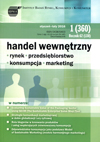Prognozowanie liczby powiadomień alarmowych systemu RASFF na podstawie danych empirycznych dotyczących metali ciężkich
Forecasting of the Number of Alert Notifications of the Rapid Alert System for Food and Feed (RASFF) Based on Empirical Data Concerning Heave Metals
Author(s): Marcin PigłowskiSubject(s): Economy, Recent History (1900 till today), Methodology and research technology, Policy, planning, forecast and speculation, EU-Approach / EU-Accession / EU-Development
Published by: Instytut Badań Rynku, Konsumpcji i Koniunktur
Keywords: heavy metals; alert notifications; RASFF; food;
Summary/Abstract: Aim: to build the model to conduct a forecast of the number of alert notifications in 2014 concerning heavy metals in food originating from all countries, the European Economic Area countries, and other countries as well as to state whether there is dependence between the group of countries (EEA and other) and the year, product category and the type of heavy metal as regards the number of alert notifications in the RASFF system towards products from these groups of countries. Research methodology: the material for the research, concerning the number of alert notifications related to heavy metals in the RASFF system, was retrieved from the that system’s database, covering with the research the period of 1980 - 2013. In order to present the variability over the time in the number of alert notifications, there were used the models of multinomial regression (from the second degree to the eight one), while in order to examine the dependency between the group of countries (EEA and other ones) and the year, category of products and the type of heavy metal – the correlation association coefficients: Chuprov’s T, Cramer’s C and corrected Pearson’s Pkor, based on the χ2 statistics. Main research findings: the adopted model of multinomial function indicates the growth in the year 2014 of the number of alert notifications in the RASFF system concerning heavy metals, reported in relation to food originating from all countries, the EEA countries and other ones. The values of correlation convergence coefficients indicate a weak dependency between the food origination from the EEA countries and other ones and the year, product category and type of heavy metal. Practical implications: the multinomial regression models well presented the variability of alert notifications over time; however, there was the need to approach with great caution to the forecasts carried out on their grounds. Social implications: based on the earlier trend in the number of notifications, one may assume that the control bodies of the EEA states should pay a particular attention to food originating from other countries, first of all, that imported from China, Vietnam, India and Thailand. Article category: research article.
Journal: Handel Wewnętrzny
- Issue Year: 355/2015
- Issue No: 2
- Page Range: 320-333
- Page Count: 14
- Language: Polish

